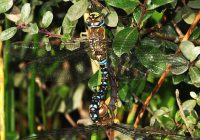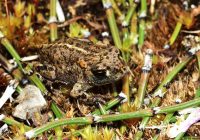Dr Phil Smith’s Wildlife Notes
September 2012
Another busy month on the Sefton Coast began with a visit to Cabin Hill National Nature Reserve where I estimated about 5000 flowering plants of Grass-of-Parnassus in one of the slacks. This may sound a lot but the plant has declined here since 2008, probably due to drier conditions and the demise of Rabbits that used to keep the coarser vegetation under control. Nearby, on the big scrape, I was pleased to find a late Emperor, arguably our most spectacular dragonfly, together with several Migrant Hawkers and Common Darters.
Some early-autumn sun on the 2nd brought out eight Common Lizards to bask on wooden posts near the Alt Centre at Hightown, while baby Natterjack Toads were still emerging from the reprofiled scrape. It was even warmer on 6th when Trevor Davenport joined me on the superb Freshfield Dune Heath Nature Reserve. The swathes of purple Heather were just past their best but Small Coppers were still flying and the ponds produced a surprising variety of dragonflies, including several Emerald Damselflies and Migrant Hawkers. The highlight, however, was four male Ruddy Darters on three different ponds; I had only seen one before here. Finally, a check of the Sand Lizard release site where baby lizards were introduced in 2010 and 2011 resulted in two sightings, one an adult male showing some green colouration. This, together with other records by Sand Lizard specialist Dave Hardaker, bodes well for the attempt to establish a new breeding colony on the heath.
Patricia Lockwood and I guided a group of 38 members of the national Wildflower Society around the Birkdale and Hightown sand-dunes on 9th. Many of them were from southern England and had not visited the area before, so they were knocked out by the variety of rare plants we were able to show them, including Baltic Rush and Sharp Club-rush at their only English and British localities respectively. Other highlights were Perennial Ragweed in great abundance at Birkdale, known from only three post-1999 sites in the UK, the British endemic Isle of Man Cabbage at Hightown and, at the same place, three nationally rare hybrid plants. It was an exhausting day but rewarding none-the-less.
Talking of hybrids, some of the Wildflower Society members had found Sticky Groundsel x Oxford Ragwort (Senecio× subnedrodensis) at Southport Marine Lake, so Pat and I went to see it the following day; it was new to both of us and to the Sefton Coast plant inventory.
A well attended conference on dune scrub and woodland organised by Hope University was an opportunity to meet up again with several British and European researchers, including Maike Isermann from Bremen who spent the summer here in 2010. Another all-day field excursion saw me leading a large party across the Birkdale Sandhills. These international experts were highly supportive of Sefton Council’s Landscape Partnership Project to control scrub and introduce livestock grazing on these dunes.
With sunny days at a premium this month, I took advantage of the weather on 22nd to do some survey work on the southern Green Beach and adjacent slacks. Migrant Hawkers were numerous, a total of 22 being logged, including pairs and egg-laying females. As usual, dozens of Common Darters were sheltering in the ley of the Green Beach Alders, while the last of the season’s Northern Dune Tiger Beetles and Dune Robber-flies hunted the embryo dunes. Then followed an unprecedented deluge of almost continuous rain from 23rd to 25th, Rachael Parks recording 105mm (four and a quarter inches) in her Formby garden. The dune water-table rose 20-30cm, while extensive flooding of mossland fields occurred. Ponds on Freshfield Dune Heath were full to the brim, even overflowing onto the normally dry heathland. It will be fascinating to see whether this translates into favourable spawning conditions for the Natterjack Toads next spring.




